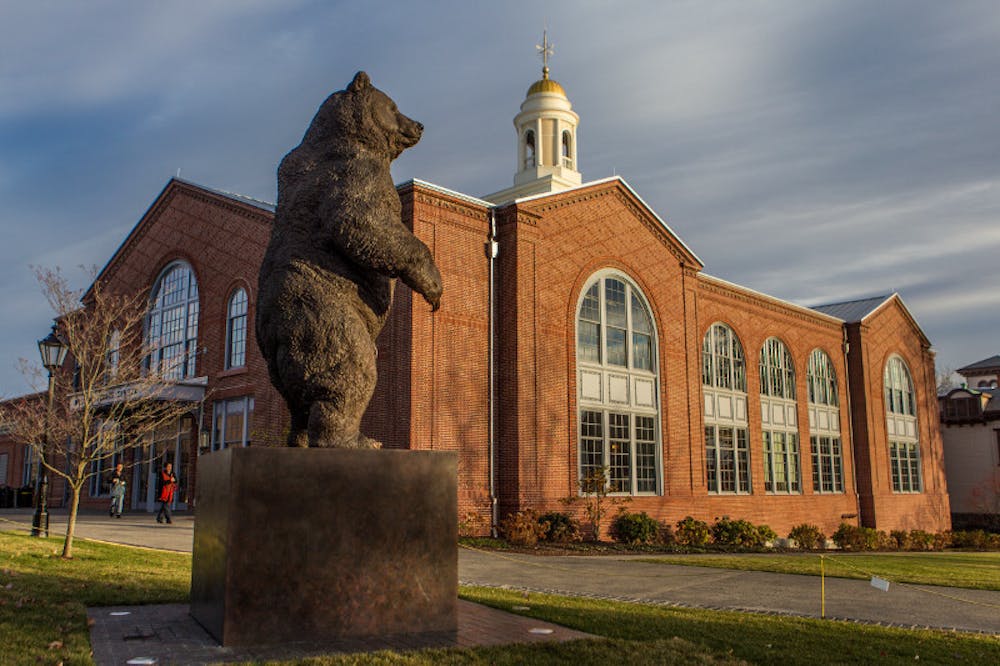The first games of the fall athletics season, which took place earlier this month for most teams, underscored a return to normalcy for the University’s athletics department.
But for sophomore student-athletes, who spent their first year at the University on the sidelines — and on Zoom — the return to competition means something more: a belated true beginning to their collegiate athletic careers.
The difference between this year and last is predictably stark, according to three fall athletes in the class of 2024. Everything has changed from their first year on campus: practices, uniforms, locker rooms, team dinners, team chemistry and full stands of spectators watching games.
Cian Carlson ’24, a defender on the men’s soccer team, said the first game of the season against the University of Hartford led to a sense of excitement and nervousness across the team. It marked the first intercollegiate competition for 17 players on the roster, he said.
“When you put on that jersey and you’ve got the B on your chest — it’s one of those things I had never experienced,” Carlson said. “It means a little more.”
Olivia Alperin ’24, a hooker and flanker for women’s rugby, shared Carlson’s sentiment. She felt jittery before the team’s opener against Army West Point — a school, she added, that is “very good at combat sports.” But the nerves quickly faded, she said, as the team took the field for the first time in nearly two years in front of a large crowd. Bruno lost in overtime in what Alperin described as the hardest game she had ever played in, but she said the passion and energy of the game rejuvenated her.
“During COVID, it was really hard to find purpose in what I was doing,” Alperin said. “When you’re doing everything full go, it’s incredible.”
Isa Stronski ’24, a member of the women’s cross country and track and field teams, said she felt overpowered by the joy of the fall’s first cross country meet.
“It was just so fun,” she said. “It had been so long since I had felt anything remotely close to that.”
But the road to this point was not simple. This year’s sophomores were high school seniors in March 2020, watching the hope for a fall season slowly slip away as the pandemic progressed. All three athletes remained connected with their teams virtually through the summer of 2020, training in accordance with their coaches’ demands, but at different points, all realized that a fall season wouldn’t be feasible.
Carlson said he held out hope until the Ivy League announced in early July 2020 that the fall season was cancelled.
Then, the University added another complicating factor: First-years would not even be invited to campus in the fall, and would instead be starting their academic careers in spring 2021. Carlson, from Madison, Wisconsin, watched his friends from high school move into the University of Wisconsin while he waited for his own college experience to start — a “weird thing to swallow,” he admitted.
Coaches “worked really hard to keep us in the loop,” Stronski said, “which is a challenge when you’re not there.”
Despite efforts by teams to include first-years, Alperin and Carlson admitted that they felt something of a disconnect from their teams in the fall. Alperin, who spent the semester as a ranch hand on a farm in northern California and then as a dog-musher in Alaska, logged on to team Zoom calls at 4 a.m. Alaska time.
When the 2021 spring semester came, Carlson recalled upperclassmen extending invitations to pick up food from the dining halls and being shown campus, while Alperin heard from multiple older players on the team checking in on her when she moved in.
But the semester didn’t match the full athletic experience that older players on the teams knew and remembered. Stronski said that while track and field found a semblance of normalcy in socially distant practices, the conditions of such practices drained intensity from soccer and rugby.
“I didn’t feel like I had a connection to the sport in the same way… when we started practicing,” Alperin said.
“The silver lining was not knowing exactly what I was missing,” Carlson added.
Stronski was one of the select University athletes who got the chance to compete this spring: a singular track meet, the day before she left College Hill for the end of the semester.
The summer, the athletes agreed, brought a sense of normalcy and added socialization that had been missing from their first semester. Come preseason in late summer 2021, the University promised the return of the full athletic experience. The classes of 2024 and 2025 had never experienced a season of competition, much less a full semester of in-person college classes.
“The freshmen and the sophomores have all the same questions,” Carlson said. “The non-soccer questions — where the dining halls are, the libraries, where’s Barus and Holley, it’s like, ‘I have no clue, dude, I took all my classes from my dorm last semester.’”
“For one of my classes, I had to ask the freshmen how to get to the building,” Stronski admitted.The shared sense of confusion, Carlson said, has promoted team bonding. Juniors and seniors feel a shared responsibility to help, while first-years and sophomores learn the ropes together and experience the quirks of an in-person season, like wearing suits to the Ratty before the first game of the year.
And the home games have special meaning, Carlson noted, now being able to look into the stands and see the familiar faces of professors, other athletes, friends and family.
“When you’re able to go on the field and stand in uniform with your teammates looking at the crowd ... that was so great,” Alperin added.
But even in the full return to play, the pandemic has impacted athletics. Alperin said that women’s rugby — and a number of other teams — have seen COVID-19 cases in recent weeks. Even if the cases are as mild as possible, she said, they knock players out of competition for nearly three weeks: 10 days of isolation and a seven-day “return-to-play” period.
“It’s really hard,” she said. “It makes you wonder when we’ll actually be able to go full-throttle.”
“I’m hoping that we’re still going forwards, not backwards,” Stronski added. “I think as a team, (we) and our coaches have been really careful ... I’m trying to stay optimistic that we’re still headed in the right direction.”

Will Kubzansky was the 133rd editor-in-chief and president of the Brown Daily Herald. Previously, he served as a University News editor overseeing the admission & financial aid and staff & student labor beats. In his free time, he plays the guitar and soccer — both poorly.





